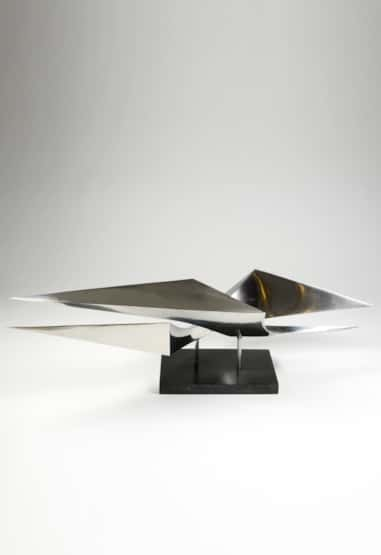Paul Mount
(1922 - 2009)
Two Part Invention
1984
P1062
Bronze
Inscribed with the artist's signature and numbered 1/5; inscribed with the artist's signature on the base
Width: 15 in (38.1 cm)
Conceived in 1984.
PROVENANCE
New Art Centre, London (acquired directly from the artist)
Acquired in September 1987 from the above by the present owner
ARTIST'S BIOGRAPHY
Paul Mount was born in Newton Abbot, Devon, to schoolteacher parents who taught at the local grammar school where he was educated. Wanting to become a painter from an early age, he studied art first at Paignton School of Art and then at The Royal College of Art until he was called up for war service. A lifelong pacifist, he drove for the Friends’ Ambulance Unit in North Africa and France during the war. In 1948 he did a spell of teaching at the Winchester School of Art, a job that subsequently led to seven years in West Africa where he moved in 1955 with his wife Jeanne Martin, a fellow student at the RCA. The job was to set up an art department at YABA College of Technology in Lagos, Nigeria. He started off with an empty building; he designed the furniture and equipment, and then recruited the students. He employed a wood-carver from Benin to teach the students marketable skills and before long, thanks to the carver, Mount found his own path as a sculptor experimenting with smooth, standing forms reminiscent of Barbara Hepworth’s work at this period while also being influenced by the tribal sculptures of the region, which had made a huge impact on him. That said, it was music and architecture that were his major sources of influence throughout his life. He once remarked: "I like form for its own sake, whether it's in sculpture, design, music, architecture or painting." In 1962 Mount and his wife returned to Britain and settled in the village of Nancherrow, Cornwall, where he was to spend the rest of his life. They divorced in 1976 and Mount went on to marry the painter June Miles, with whom he forged an ideal working partnership. Barbara Hepworth was still working in nearby St Ives, and Mount, like her and her sometime assistants Denis Mitchell and John Milne, conceived his sculpture in relation to the Cornish landscape. His fascination with machinery, however, led him to develop more angular, industrial forms than other Cornish modernists later on in his career, closer to those of the Basque sculptor Eduardo Chillida, whom he met in France in the 1970s. Paul Mount’s work has been shown in Spain, Germany, Switzerland and the US, as well as with numerous galleries and sculpture parks in Britain. His first solo show in London was with Drian Gallery in 1965, and he later showed with John Whibley Gallery on Cork Street, as well as having a solo show with Marlborough Fine Art in 1975, He has also exhibited at the New Art Centre, Roche Court, and at the Penwith Society of Arts in St Ives. He also exhibited from home, and had a sign on the road entering St Just enticing motorists to enter and see a display of his and his wife’s work. Throughout his career he also worked closely with architects, producing integral sculpture as part of buildings all over the world, from Chase Manhattan Bank in Lagos to a supermarket in Falmouth. Other commissions include the Spirit of Bristol, in St. James's Square, Bristol; the British Steel Corporation, London and the Cabinet Offices, Accra, Ghana. For Mount, sculpture expressed an essential human dignity. "The way that two shapes relate," he observed, "is as important as the way two people relate."

YOU MAY ALSO LIKE
Paul Mount
Two Part Invention






 PRINT
PRINT SHARE
SHARE


